Cohen, Peter (1989),
Cocaine use in Amsterdam in non-deviant subcultures. In: Peter Cohen (1990),
Drugs as a social construct. Dissertation. Amsterdam, Universiteit
van Amsterdam. pp. 117-123.
© Copyright 1990 Peter Cohen.
All rights reserved.
8. Set and setting of cocaine use
Peter Cohen
- 8.1 - Introduction
- 8.2 - Situations in which cocaine use occurs
- 8.3 - Emotional states in which cocaine use occurs
- 8.4 - Persons with whom cocaine is not used
- 8.5 - Rules that are applied to control cocaine use
Table of contents
8.1 Introduction
Emotional and social situation of a person has a significant impact on drug use. Set and setting may determine not only the effects of use, but also the choice of drug itself.
To know more about the set and setting factors that play a role for our sample of cocaine users, we asked an open-ended question which gave respondents the chance to first mention situations, and then feelings or emotional states in which they used cocaine during the previous three months. If respondents had not used cocaine in the previous three months, they could answer the question for the period in which they previously used.
Situations and emotional states in which cocaine use occurred could be mentioned up to a maximum of five each. For both situation and emotional state we additionally asked frequency of occurrence, and we also tried to find out if the occurrence of a mentioned situation or emotional state actually created appetite for cocaine.
8.2 Situations in which cocaine use occurs
Our data revealed the following categories of situations for cocaine use (abbreviations used in the tables which follow are given in square brackets):
Going out for dancing or meeting people (cafe, bar, disco) [going out], going to a private party [party], meeting of friends at home [friends], around dinner (before, during or just after) [dinner], alone at home [home], going to theatre, concert [theatre], in erotic or sexual situations [sex], wanting to continue (working, playing, partying, love making) [continuation], after having accomplished something, self gratification [self-gratification].
Situations in which people enjoy each other's company are most frequently mentioned as those where cocaine use occurs. Less frequent, but clearly visible, are two situations in which people act more individually. In spite of cocaine's fame as an aphrodisiac, situations in which sex is involved are mentioned only by a small minority.
Table 8.2.a Situations in which cocaine use occurs often, sometimes or rarely; and causal relation between situation and appetite for cocaine (N=160)
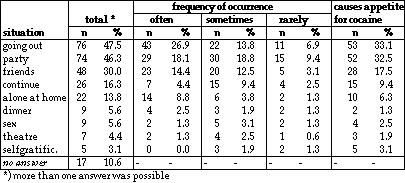
Table 8.2.b Situations in which cocaine is not used (N=160)
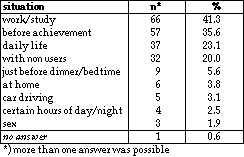
We might infer from these data that use of cocaine is strongly related to lifestyles in which outgoing and socializing behaviour is dominant. We have already noted that most cocaine was used at weekends, when people have ample opportunity for social gatherings (see Table 3.7.b). Longitudinal panel research is necessary to discover if changes in lifestyles are related to changes in drug (cocaine) use, and how this relationship works.
Of course just as important are situations not selected for cocaine use. Situations in which cocaine is explicitly not used are shown in table 8.2.b.
The situations mentioned are the opposite of the recreational situations that were reported as suitable for cocaine use. Clearly setting is an important aspect for the cocaine users in this sample.
8.3 Emotional states in which cocaine use occurs
We also asked our respondents which emotional states generate a liking or appetite for cocaine. This was asked as an open-ended question. Answers were reduced to the following categories (between square brackets are the abbreviations used in Table 8.3.a): [excitement], feelings of joy, exuberance, festivity [joy], being in love, being sexually excited [in love], energetic, ambitious [energetic], insecure, shy [shy], tired, flat [tired], melancholic, depressed [depressive], frustrated, restless [frustrated], [bored], wanting to be detached, to forget, to explode [explode].Table 8.3.a Emotional states in which appetite for cocaine use can be generated often, sometimes or rarely (N=160)
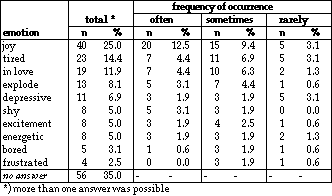
The two most often mentioned emotional states that generated the appetite for cocaine use were joy and being tired, both perfectly comprehensible in an outgoing lifestyle. Unfortunately only a very small number of emotional states are given by respondents, not even one per person. Apparently it is easier to mention settings (1.7 per respondent) than sets.
Feelings or emotional states in which cocaine is explicitly not used are mentioned with the frequencies shown in table 8.3.b.
Feeling not well or down is mentioned most often as incompatible with cocaine use, which is surprising. One would expect cocaine to be used exactly in those states of mind because of its apparently euphoric characteristics.
Table 8.3.b Emotional states in which cocaine is not used (N=160)
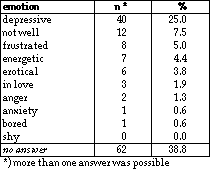
8.4 Persons with whom cocaine is not used
To use cocaine alone appears to occur quite often. Of the total sample 59.4% used cocaine occasionally when alone, versus 39.4% who never did so. When asked if they could mention a category of persons with whom they would definitely not use cocaine, only 117 respondents (73.1%) answered in the affirmative. When asked explicitly to name category, 145 respondents did so:Table 8.4.a Category of persons with whom respondents would definitely not use cocaine (N=160)
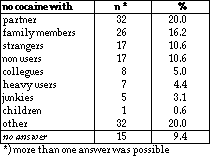
Partner or members of the family were mentioned by 36% of the respondents who answered this question. This leaves no doubt about the relative cultural isolation in which cocaine use takes place for part of this sample.
8.5 Rules that are applied to control cocaine use
In paragraphs 8.1 to 8.4 we saw that many respondents recognize situations, feelings or persons that play a role in the use or non use of cocaine. These recognitions could be considered as part of the control system that is active when people consume drugs. Control mechanisms or rules of use was a separate and overt item in our questionnaire. We simply asked respondents if they had any rules that would control cocaine use, and if so, what they were. We wanted to know if these rules were statements in which situations, feelings of persons could be recognized or amalgamated.
Categories of rules of use were (abbreviations for Tables are in square brackets): [not alone], not earlier than a certain time of the day [not earlier], use if you have the next day available for resting or sleeping [next day], use no more than a certain amount [amount], do not use when working, doing sport or studying [work/study], not during week or only rarely during week [week], not before dinner [dinner], do not use more often than N times per time period [time period], when using cocaine check alcohol intake [alcohol], stop if feeling certain effects [effect], take into account how situation relates to cocaine use [account], not with certain persons [persons], not when feeling depressed [depressive], not before sleeping [sleep], don't always accept cocaine when offered, use only own cocaine [habit], never buy cocaine [don't buy], not with sex [sex], don't accept from strangers [strangers], only good quality cocaine [quality] and limits on purchase of cocaine [$ limits].
Table 8.5.a Rules applied to control cocaine use (N=160)
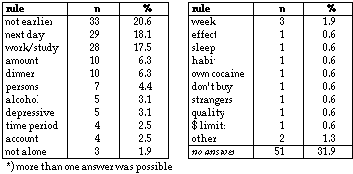
The large 'no answer' category is probably due to interviewer bias. To persuade respondents to answer this question sometimes needed more assertive questioning than some interviewers were willing to adopt.
Persons or feelings are rarely mentioned: situations or activities dominate rule-making. Because cocaine, like alcohol, creates adverse effects after a certain dose, the absence of rules that relate to effects or dose is striking. In the chapter about perceived advantages and disadvantages of cocaine use (chapter 9) there is information about dose-related adverse effects, which shows that users are well aware of these. Probably we can only gain deeper knowledge about rules when we painstakingly question users about this. It is clear that this aspect needs further research.An interesting item relates to limits to the purchase of cocaine. When our respondents were asked explicitly about this exactly 50% stated they had upper limits to the amount of cocaine they bought per month. Another 36.2% did not have an upper limit and of 13.8% we don't know. Apparently establishing purchasing limits is not seen as a rule relevant for cocaine use,
Table 8.5.b Presence of financial limits on cocaine purchases and level of use during top period

because only 1 respondent reported this when asked overtly for rules. As far as the amount of money respondents limit their cocaine purchases to, only 68 persons answered with a definite figure, with an average of Ÿ 233 per month (range Ÿ 50 - Ÿ 2,000). In table 7.2.b we saw that the 66 persons who knew the value of cocaine they had bought during the four weeks prior to the interview spent an average of Ÿ 246 each. It seems rather peculiar that the average limit value is slightly lower than the average amount of money spent on cocaine. The explanation is that the two sub-groups who furnished the data for these computations do not completely overlap. We may cautiously conclude from these data that in as far people set upper limits to cocaine purchases per month, they succeed fairly well in abiding by these limits.
Table 8.5.c Level of financial limit on purchase of cocaine and level of use during top period (f 1 ~$ 0.50 )
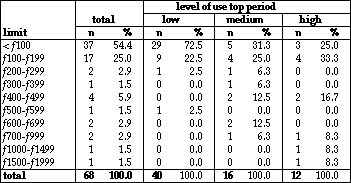
We can only speculate about the relative importance of having a financial limit on the actual level of cocaine consumption. When we cross tabulate having or not having such a limit with level of use in the top period, we do not find any relationship (see Table 8.5.b).
There does not exist any significant difference between high, medium and low level users (during top period) in reporting the presence of a financial limit on cocaine purchase. This means that for our sample the presence of a purchasing limit will not predict anything about use level.
But, within the group of respondents that reported having a financial limit on cocaine purchase, this limit correlates significantly with level of use during top period. (Pearson's r=0.48, p < 0.0001). A very unsurprising finding.
